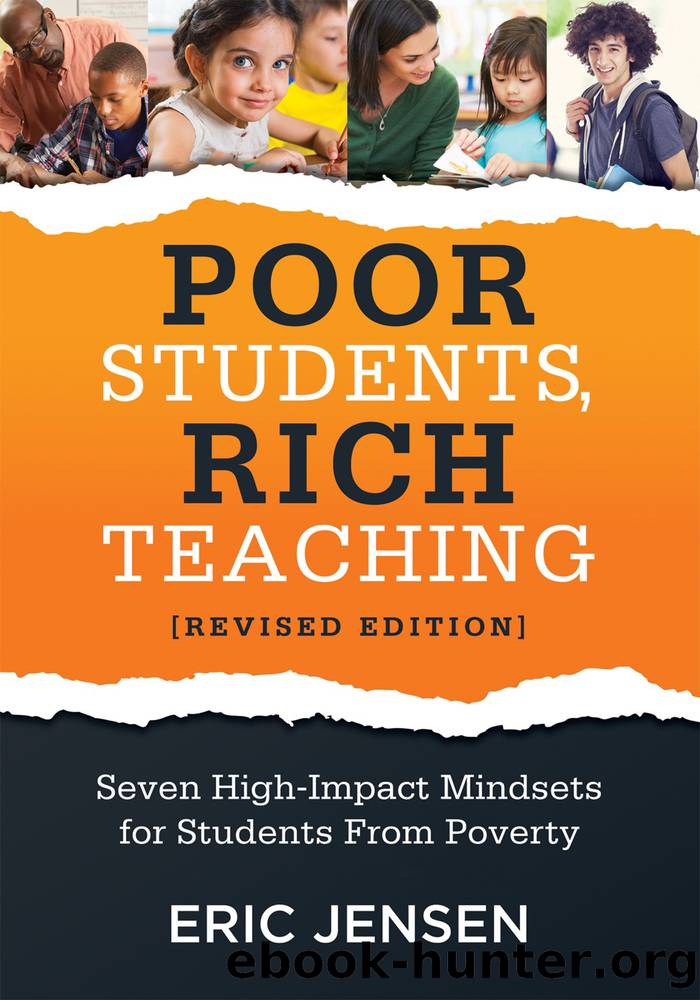Poor Students, Rich Teaching by Eric Jensen

Author:Eric Jensen
Language: eng
Format: epub
Publisher: Solution Tree Press
Published: 2019-09-14T16:00:00+00:00
Figure 14.1: Basic problem-solving thinking model.
Remember, a model is an outline of a procedure. Over time, a more advanced learner may embellish it or find shortcuts. But in the beginning, models can be priceless windows into the mental world of thinking skills. Using models is in my top-five list for smart cognitive skill building.
Use Student Verbalization
Ask students to talk through the process of solving a problem. This allows them to better reflect on and receive feedback for their thinking process to improve its quality. This process ranks high in contributing to student achievement. It has a 0.64 effect size, putting it in the top 25 percent of all factors (Hattie, 2009). Hereâs how to use this strategy.
1. Students select the problem at their seats and work with partners to talk through it both before they try it out and during the actual problem solving.
2. Students stand as they share their thinking during a whole-class discussion; you help guide them to think more deeply or find more useful ways of understanding a topic.
Use Powerful Questions
Teachers whose students struggle with reasoning typically ask one or two questions, often those that probe for answers like, âWhat is â¦?â or âWhich of the â¦?â Teachers who excel at teaching reasoning use a sequence of questions to develop thinking. You might hear the following questions. Visit go.SolutionTree.com/instruction for a reproducible of these questions.
⢠âTell me again please, what claim are you making?â
⢠âWhatâs your evidence for saying that?â
⢠âCan you connect what (another student) just said to your comments? Do you feel different or the same; do you agree or disagree?â
⢠âIf that happened, what might happen next?â
⢠âWhat are probable causes for that?â
⢠âWhy did they do it this way, and can you think of other ways to do it?â
You will want to have your own process for using powerful questions. Hereâs mine.
⢠Provide sufficient wait time (five to ten minutes).
⢠Model how to answer (say, âThat is true because of â¦â).
⢠Never accept easy answers (such as, âYes,â or âNo,â or âI donât knowâ). Challenge students to do more. Ask them to listen to the next two students and then make a fresh guess.
⢠Keep higher-order question stems posted and refer to them often. Ensure everyone participates, and thank each student for contributing. (âHow would you respond to the criticism that ___________?â âIn what way could you explain that to a newcomer?â âWhat could be an alternative explanation for your conclusion?â âWhat might an outsider to this issue say?â âWhat is your strongest argument that this is true?â âIf it was false, what would be the most likely reason?â)
You can say, âThanks for jumping inâ or âI love your ideas.â The core understanding here is simple. Reasoning skills, one of the absolute basics of higher-order thinking and executive functioning, are a teachable process. If you fail to teach them, your students may miss out for the rest of their lives on the skills you take for granted. Now, letâs take your students to an even higher cognitive level.
Download
This site does not store any files on its server. We only index and link to content provided by other sites. Please contact the content providers to delete copyright contents if any and email us, we'll remove relevant links or contents immediately.
The Data Detective by Tim Harford(949)
Mind Management, Not Time Management by David Kadavy(624)
100 Tricks to Appear Smart in Meetings by Sarah Cooper(601)
GMAT For Dummies 2021 by Lisa Zimmer Hatch & Scott A. Hatch(589)
Amazing Decisions by Dan Ariely(494)
The Smart Strategy Book by Kevin Duncan(434)
The Data Science Framework by Unknown(417)
99 Financial Terms Every Beginner, Entrepreneur & Business Should Know (Financial IQ Series Book 1) by Herold Thomas(398)
The Store Detective Training Manual: A Practical Reference for Current and Aspiring Loss Prevention Officers by Glen Canarte(373)
Poor Students, Rich Teaching by Eric Jensen(334)
Robert's Rules of Order by Henry M. Robert(332)
Side Hustles: How to Make Extra Money Online by Hayden Vernon(309)
Arts, Sciences, and Economics by Tönu Puu(307)
97 Things Every Information Security Professional Should Know by Christina Morillo(304)
Sustainable Education and Development by Unknown(298)
Cambridge IGCSE and O Level Business Studies by Karen Borrington(298)
Excel 2016 for Marketing Statistics by Thomas J. Quirk & Eric Rhiney(293)
Enterprise Analytics by Thomas H. Davenport(289)
Information Literacy in Higher Education by unknow(282)
